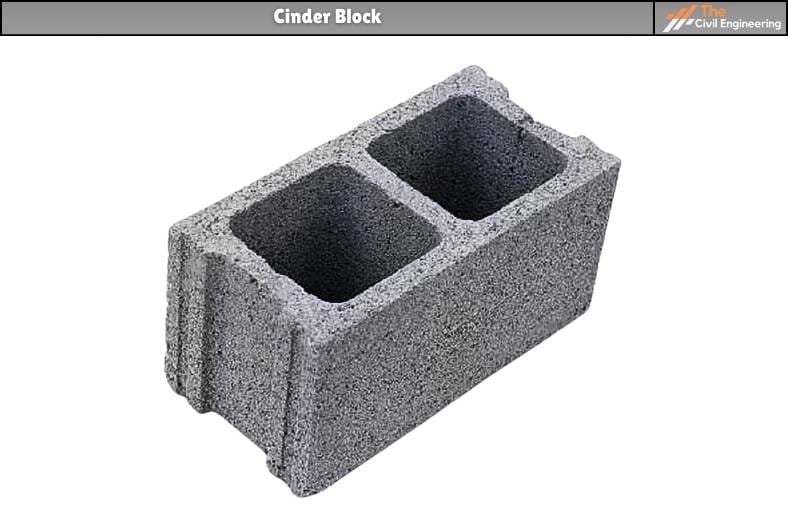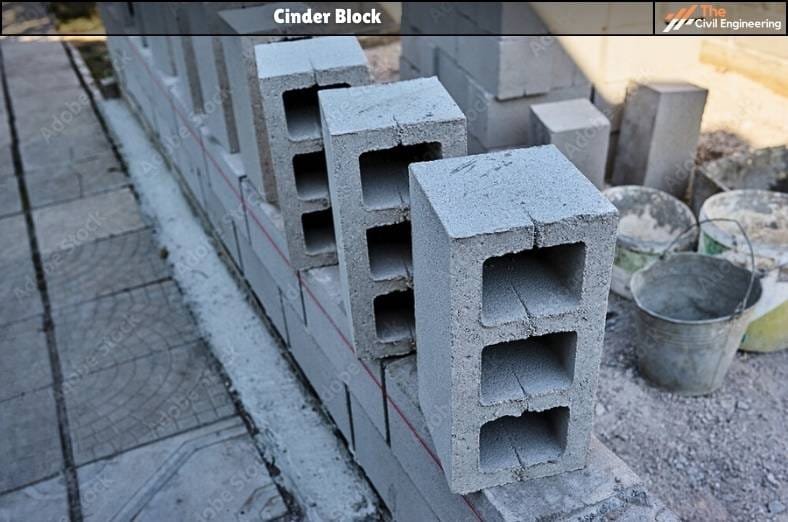1. Introduction

✔ Cinder blocks are rectangular hollow structures made of Concrete, using coal cinders (fly ash/bottom ash) instead of aggregates to build walls at construction sites.
✔ Commonly, fly ash is utilized as aggregate in the cinder block.
2. How cinder blocks and concrete blocks are different?
| Aspect | Cinder Blocks | Concrete Blocks |
| Composition | Coal cinders, Clay or shale, cement, sand, water | Water, sand, gravel, cement |
| Weight | Lighter (25-35 lbs) | Heavier (42-55 lbs) |
| Strength | Lower strength (up to 1,500 psi) | Higher strength (up to 5,000 psi) |
| Durability | Less durable, prone to cracking | More durable, resistant to weathering |
| Thermal Insulation | Better insulation | Less efficient insulation |
| Appearance | Rough texture, grey | Smoother surface, various colors |
| Specific Use | Non-load-bearing | Load-bearing |
| Aesthetics | Limited options | More options for decorative designs |
| Cost | Cheap | Expensive |
3. Composition and manufacturing process of Cinder Block

Composition of materials in percentage:
| Material Component | Approximate Percentage Composition |
| Coal Cinders | 70% – 85% |
| Clay or Shale | 5% – 15% |
| Sand | 5% – 15% |
| Portland Cement | 5% – 10% |
| Water | Varies (used for mixing) |
Manufacturing Process Table:
| Step | Description |
| Mixing | ✔ Coal cinders, Clay or shale, cement, sand, and water are mixed precisely to form the concrete batch. |
| Molding | ✔ The mixture is poured into molds shaped like cinder blocks. |
| Vibration | ✔ Molds are subjected to vibration to remove air bubbles and ensure uniform distribution of materials. |
| Curing | ✔ Blocks are cured in a controlled environment, allowing the cement to hydrate fully. |
| Quality Control | ✔ Each block is inspected for quality, including dimensions, strength, and surface finish. Blocks that do not meet the required standards are rejected. |
| Packaging and Storage | ✔ Cured and approved blocks are packaged and prepared for distribution to construction sites. |
4. Properties of Cinder Blocks
- Composition: Cinder blocks are made up of coal cinders (70% – 85%), clay or shale (5% – 15%), sand (5% – 15%), Portland cement (5% – 10%), and water.
- Weight: Cinder blocks typically weigh 25 to 35 pounds, making them lighter than concrete blocks.
- Strength: Cinder blocks typically have a lower compressive strength than concrete blocks, with a maximum of 1,500 psi.
- Durability: Non-load-bearing applications may be more suitable for these less durable materials, which may be more prone to cracking.
- Thermal Insulation: Cinder blocks can offer better thermal insulation than concrete blocks due to their low density.
- Appearance: Cinder blocks typically have a rough texture and are often found in varying shades of gray.ng shades of gray.
- Specific Use: Cinder blocks are commonly used for non-load-bearing walls, partitions, and decorative purposes.
- Aesthetics: With their limited aesthetic options, cinder blocks can still be effectively used in various decorative designs by adding finishes.
5. Common Applications of cinder block
| Use | Description |
| Retaining Walls | Used to hold back soil and prevent erosion on sloping terrain. |
| Garden Walls | Creates defined and organized spaces in gardens, separating different areas. |
| Privacy Fencing | Part of sturdy and durable privacy fences when combined with other materials. |
| Raised Garden Beds | It is famous for constructing raised beds and providing structured gardening spaces. |
| Decorative Features | Used to create decorative elements like planters, benches, and outdoor seating areas. |
| Sound Barriers | Included in sound barrier walls to reduce noise pollution along highways or industrial areas. |
| Temporary Barriers | Serves as temporary barriers, roadblocks, or crowd control measures when needed. |
| Erosion Control | Used for building check dams in streams or rivers to slow water flow and reduce soil erosion. |
| DIY Projects | Commonly used in DIY projects, including outdoor furniture and bookshelves. |
6. Cinder Block Sizes with weight
| Size (inches) | Weight (pounds) | Weight (kilograms) |
| 4″ x 8″ x 16″ (solid) | 33 | 15 |
| 4″ x 8″ x 16″ (hollow) | 26 | 12 |
| 6″ x 8″ x 16″ (solid) | 51 | 23 |
| 6″ x 8″ x 16″ (hollow) | 32 | 14 |
| 8″ x 8″ x 16″ (solid) | 51 | 23 |
| 8″ x 8″ x 16″ (hollow) | 38 | 17 |
Please note that the weight of cinder blocks may slightly vary depending on their specific composition and manufacturer.
7. How to Work with Cinder Blocks?
✔ Before working with cinder blocks, you must consider the following information.
| Material/Tool | Purpose |
| Cinder blocks | ✔ Building blocks for your project. |
| Mortar mix | ✔ Used to bond cinder blocks together. |
| Water | ✔ Mixed with mortar to create the bonding paste. |
| Trowel | ✔ For applying mortar and shaping joints. |
| Level | ✔ Ensures blocks are level and plumb. |
| Measuring tape | ✔ Used for accurate measurements and layout. |
| Hammer | ✔ For cutting or shaping blocks if needed. |
| Nails (for attaching blocks) | ✔ Secure blocks to other surfaces, if required. |
| Safety gear (gloves, safety glasses, and a dust mask) | ✔ Protects against potential hazards. |
Step-by-Step Guide:
| Step | Description |
| Plan Your Project: | ✔ Determine dimensions and layout.✔ Calculate blocks and mortar needed. |
| Prepare the Site: | ✔ Clear debris and obstacles.✔ Use stakes and string lines for guidance. |
| Mix Mortar: | ✔ Follow the manufacturer’s instructions to create mortar paste. |
| Lay the First Course: | ✔ Start at a corner and apply mortar on the ground.✔ Position and level the first block.
✔ Add mortar between adjacent blocks. |
| Continue Building: | ✔ Place subsequent blocks next to or atop the first.✔ Ensure levelness and plumpness.
✔ Apply mortar to bond blocks. |
| Cut Blocks (if needed): | ✔ Use a hammer, chisel, or saw to fit blocks in spaces. |
| Secure Corner Blocks: | ✔ Utilize corner blocks or miter-cut regular blocks for square and level corners. |
| Finish Your Project: | ✔ Build courses to the desired height.✔ Allow the mortar to dry and cure per the manufacturer’s instructions. |
| Clean Up: | ✔ Remove excess mortar with a wire brush or trowel.✔ Properly dispose of waste materials. |
| Optional Finishes: | ✔ Customize appearance with paint or veneer/stucco. |
8. Cinder Block Cost
The cost of cinder blocks may fluctuate depending on several factors, such as their size, type, density, and point of sale. However, a general approximation would be in the range of $1 to $5 per block.
The following table shows the approximate cost of common cinder block sizes in the United States:
| Size (inches) | Cost (per block) |
| 4″ x 8″ x 16″ (solid) | $1.50-$3.00 |
| 4″ x 8″ x 16″ (hollow) | $1.00-$2.50 |
| 6″ x 8″ x 16″ (solid) | $2.00-$4.00 |
| 6″ x 8″ x 16″ (hollow) | $1.50-$3.50 |
| 8″ x 8″ x 16″ (solid) | $2.50-$5.00 |
| 8″ x 8″ x 16″ (hollow) | $2.00-$4.50 |
9. Advantages of Cinder Block
Some advantages of cinder block are:
Affordability: Cost-effective construction material.
Durability: Strong and long-lasting.
Fire Resistance: Excellent fireproof properties.
Low Maintenance: Requires minimal upkeep.
Sound Insulation: Provides some noise reduction.
Versatility: Various sizes and shapes are available.
Energy Efficiency: Helps regulate indoor temperatures.
Ease of Installation: Suitable for DIY projects.
Environmentally Friendly: Locally sourced and long-lasting.
10. Disadvantages of Cinder Block
Some of the disadvantages of the cinder block are:
Poor Insulation: Low thermal resistance, leading to energy inefficiency.
Heavy and Bulky: Difficult to handle and transport.
Limited Aesthetic Appeal: May not fit various architectural styles.
Prone to Cracking: Over time, cracks can develop.
Moisture Absorption: Can absorb moisture, causing mold and mildew.
Skilled Labor Required: Installation often demands skilled professionals.
Sound Transmission: Offers poor sound insulation.
Limited Load Capacity: May need additional reinforcement for heavy loads.
Efflorescence: Can develop unsightly white deposits on the surface.
11. Cinder Block Finishes and Designs
Here are some techniques to decorate and enhance your cinder block surface:
1. Painting:
✔ Operate masonry paint with a roller or sprayer to effortlessly reach various colors.
✔ Involve a sealer or primer ahead for more reasonable sticking and longevity.
✔ Create a unique visual style by integrating stenciling or mural painting.
2. Stucco:
✔ Traditional stucco combines cement, sand, and water for a greasy, textured finish.
✔ Acrylic stucco is a modern alternative that is more flexible and easier to apply.
3. Veneers:
✔ Thin stone or brick veneer panels can be applied to achieve a high-end look.
✔ Decorative ceramic or mosaic tiles can add an artistic element.
4. Texture Coatings:
✔ Lay textured layers or paints to acquire multifarious textures, ranging from smooth to rough.
✔ Some coatings possess sand or small stones for added depth and texture.
5. Plantings and Greenery:
✔ Incorporate vertical gardens or planters to achieve a natural and sustainable finish.
6. Tile or Stone Cladding:
✔ Connect ceramic or natural stone tiles with mortar or sealant for a durable and visually appealing finish.
7. Wood Paneling or Siding:
✔ Lay wooden panels or siding to reach a warm, rustic look that can sweeten insulation.
8. Polished Finish:
✔ Polish the surface of the cinder blocks to perpetrate a smooth and glossy finish that induces remarkable results.
12. Cinder Blocks vs. Other Building Materials
| Characteristic | Cinder Blocks | Bricks | Concrete Blocks | Poured Concrete |
| Chief Material | ✔ Concrete, cinders | ✔ Clay | ✔ Concrete, aggregate | ✔ Concrete |
| Strength | ✔ Low | ✔ Medium | ✔ High | ✔ Highest |
| Durability | ✔ Low | ✔ Medium | ✔ High | ✔ Highest |
| Weight | ✔ Lightweight | ✔ Heavy | ✔ Medium | ✔ Heavy |
| Workability | ✔ Easy | ✔ Difficult | ✔ Difficult | ✔ Very difficult |
| Cost | ✔ Low | ✔ Medium | ✔ Medium | ✔ High |
| Versatility | ✔ Medium | ✔ High | ✔ High | ✔ Highest |
| Water resistance | ✔ Poor | ✔ Good | ✔ Good | ✔ Excellent |
| Paintability | ✔ Difficult | ✔ Good | ✔ Difficult | ✔ Difficult |
| Finish options | ✔ Limited | ✔ Wide | ✔ Limited | ✔ Limited |
| Read Also: Partition Wall |
13. FAQ
1. How much does a cinder block weigh?
✔ Cinder block weighs around 12 kg to 25 kg.
2. How much do cinder blocks Cost?
✔ The average cinder block cost is $1 to $5 each.
3. How tall is a cinder block?
✔ The cinder blocks are commonly 16 in (410 mm) tall.
4. How big is a cinder block?
✔ Cinder blocks are 16 (410 mm) long and 8 (200 mm) wide. They are lightweight and offer strength, durability, fire resistance, excellent acoustic insulation qualities, energy-saving, and affordable price.
| Read Also: Mortar |
| Read More: Cement |
